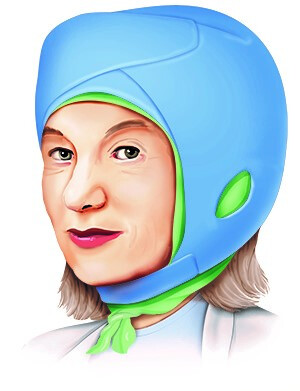NCBI Bookshelf. A service of the National Library of Medicine, National Institutes of Health.
InformedHealth.org [Internet]. Cologne, Germany: Institute for Quality and Efficiency in Health Care (IQWiG); 2006-.
There is no reliable way to prevent chemotherapy-related hair loss. Some patients try cooling their scalp during the treatment. But there hasn't been much good research on this approach.
If you are having chemotherapy, you may lose your hair, depending on which medication is used. Even though the hair usually grows back after chemotherapy, this side effect is especially upsetting for many cancer patients. There is no way to reliably prevent or treat this kind of hair loss. Adults who would still like to try to prevent it can ask their doctor about scalp cooling. In Germany and other countries, statutory health insurers don’t cover the costs of this approach, so you will have to pay for it yourself.
How does scalp cooling work?
Chemotherapy is given in cycles of treatment: You are given the cancer medications on the treatment days, usually in the form of an infusion (a "drip"). After that, there's a break until the next dose of medication is given. The break lasts about two to four weeks, depending on the medication.
Your scalp is cooled while you are receiving the infusion. Sometimes the cooling is started ten to twenty minutes beforehand, and can be continued for up to one and a half hours afterwards.
To cool your scalp, you wear a helmet-like cooling cap. You usually wet your hair before the cooling cap is put on. Most modern models are attached to an instrument that pumps a liquid coolant through the cap to cool the scalp to about 20 degrees Celsius (68 degrees Fahrenheit). Other caps have cooling elements filled with gel. They are deep-frozen before the treatment is started. For chemotherapy infusions that last longer, these caps may need to be replaced by freshly cooled caps several times over the course of the infusion.

Cooling cap
How is scalp cooling supposed to prevent hair loss?
The cooling causes the blood vessels in the scalp to become narrower. As a result, less blood reaches the cells in the roots of the hair. The cold also slows down the metabolism of the hair root cells somewhat. It is thought that this causes less of the chemotherapy medication to enter the hair root cells, so they are less damaged.
How well does scalp cooling work?
There are only few good-quality studies on scalp cooling. Overall, they show that people who did have scalp cooling treatment during their chemotherapy lost less hair than those who didn't have this treatment. They were less likely to need a wig after chemotherapy, for example.
These results aren't very conclusive though: Very few people took part in the studies, and there were usually many more women than men. Different cancer medications were used, and the duration of the chemotherapy varied. Various types of cooling caps were used too, and the extent of hair loss was measured in very different ways across the studies.
What are the possible disadvantages?
In general, scalp cooling is well tolerated and low-risk. Although it causes less of the chemotherapy medication to reach the scalp, there's no evidence that the cooling reduces the effectiveness of the chemotherapy.
The most common side effect is a headache. But some people find the cold to be so unpleasant that they stop the cooling.
Cooling caps are only suitable for preventing the loss of hair on the scalp. For some people, though, the loss of eyelash hair or eyebrow hair is particularly upsetting. For men, the loss of facial or body hair can be more of a problem than the loss of hair on the scalp.
Does anything else help prevent hair loss?
Pressure on the scalp (scalp compression)
Some people try to prevent hair loss by exerting pressure on the scalp. This involves the use of tourniquets or tight caps. They cause less blood to reach the scalp, which is meant to reduce the amount of cancer medication that enters the hair roots. But there’s no proof that this method works. In studies, it only helped to prevent hair loss when it was used in combination with scalp cooling.
Medication
There is currently no medication that can prevent chemotherapy-related hair loss. Some people try out hair-growth products that are applied to the scalp, like those containing the drug minoxidil. But this drug wasn’t found to prevent hair loss in studies. It also isn’t clear whether hair grows back faster after the treatment if hair-growth products are used during chemotherapy. The possible side effects of minoxidil include an irregular heartbeat and swelling due to water retention in the tissue. If you take medication to reduce your blood pressure, minoxidil might increase the effect of that medication, causing dizziness or fainting.
Diet
Some vitamins and foods such as millet are considered to boost hair growth and are available as dietary supplements. But there's no proof that they can prevent chemotherapy-related hair loss or other forms of hair loss.
Sources
- Deutsche Krebsgesellschaft (DKG), Deutsche Krebshilfe (DKH), Arbeitsgemeinschaft der Wissenschaftlichen Medizinischen Fachgesellschaften (AWMF). Supportive Therapie bei onkologischen PatientInnen (S3-Leitlinie). AWMF-Registernr.: 032-054OL. 2020.
- Hilton S, Hunt K, Emslie C et al. Have men been overlooked? A comparison of young men and women's experiences of chemotherapy-induced alopecia. Psychooncology 2008; 17(6): 577-583. [PubMed: 17957733]
- Rugo HS, Melin SA, Voigt J. Scalp cooling with adjuvant/neoadjuvant chemotherapy for breast cancer and the risk of scalp metastases: systematic review and meta-analysis. Breast Cancer Res Treat 2017; 163(2): 199-205. [PMC free article: PMC5410200] [PubMed: 28275922]
- Rugo HS, Voigt J. Scalp Hypothermia for Preventing Alopecia During Chemotherapy. A Systematic Review and Meta-Analysis of Randomized Controlled Trials. Clin Breast Cancer 2018; 18(1): 19-28. [PubMed: 28939291]
- Santos Z, Avci P, Hamblin MR. Drug discovery for alopecia: gone today, hair tomorrow. Expert Opin Drug Discov 2015; 10(3): 269-292. [PMC free article: PMC4339524] [PubMed: 25662177]
- Shah VV, Wikramanayake TC, DelCanto GM et al. Scalp hypothermia as a preventative measure for chemotherapy-induced alopecia: a review of controlled clinical trials. J Eur Acad Dermatol Venereol 2018; 32(5): 720-734. [PMC free article: PMC8127610] [PubMed: 28976026]
- Shaw J, Baylock B, O'Reilly A et al. Scalp cooling: a qualitative study to assess the perceptions and experiences of Australian patients with breast cancer. Support Care Cancer 2016; 24(9): 3813-3820. [PubMed: 27061409]
- Shen XF, Ru LX, Yao XB. Efficacy of scalp cooling for prevention of chemotherapy induced alopecia: a systematic review and meta-analysis. Eur Rev Med Pharmacol Sci 2021; 25(16): 5090-5103. [PubMed: 34486683]
- Shin H, Jo SJ, Kim DH et al. Efficacy of interventions for prevention of chemotherapy-induced alopecia: a systematic review and meta-analysis. Int J Cancer 2015; 136(5): E442-454. https://www.ncbi.nlm.nih.gov/pubmed/25081068 [PubMed: 25081068]
IQWiG health information is written with the aim of helping people understand the advantages and disadvantages of the main treatment options and health care services.
Because IQWiG is a German institute, some of the information provided here is specific to the German health care system. The suitability of any of the described options in an individual case can be determined by talking to a doctor. informedhealth.org can provide support for talks with doctors and other medical professionals, but cannot replace them. We do not offer individual consultations.
Our information is based on the results of good-quality studies. It is written by a team of health care professionals, scientists and editors, and reviewed by external experts. You can find a detailed description of how our health information is produced and updated in our methods.
- Hair loss in chemotherapy: Learn More – Can chemotherapy-related hair loss be pr...Hair loss in chemotherapy: Learn More – Can chemotherapy-related hair loss be prevented? - InformedHealth.org
Your browsing activity is empty.
Activity recording is turned off.
See more...
